The Thermal Data
A total of 6 tests were conducted at 1.0 GPM with fan speeds of 750 rpm, 1300 rpm and 1850 rpm being run in ‘Push Only’ and ‘Push/Pull’. All inclusive this testing takes between 40 – 50 hours of logging time (plus processing the data) to get the results that are presented.
Below is the final data results gathered from at least 5 data logging runs at the flow rate and fan rpm combination. The most stable 15 minute period from each logging run was used and then averaged with the other runs to obtain the data for the table below. A total of 16 temperature sensors are used in the thermal test chamber (8 air in, 2 air out, 3 water in, 3 water out). Each sensor takes a reading every second and is logged via a CrystalFontz unit.
The data in the table below is the averaged results of the logging runs which has then been used to create all the plots and tables there-after.
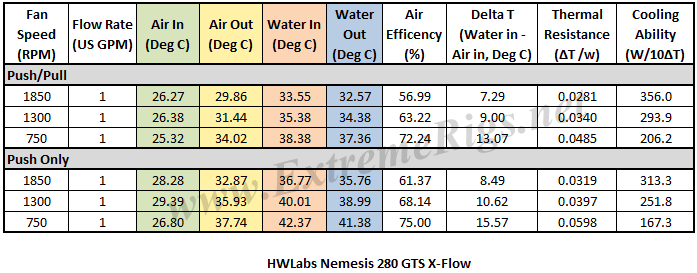 The performance metric of critical importance is the delta between the warm coolant temperature in and the cool ambient air temperature going into the radiator. Given that the system is well insulated and in equilibrium and we know the heat input to the system then we can also calculate a very important number. That number is the amount of power required to raise the coolant temperature by set amount. That amount is typically 1C or 10C. The latter is a more useful reference point.
The performance metric of critical importance is the delta between the warm coolant temperature in and the cool ambient air temperature going into the radiator. Given that the system is well insulated and in equilibrium and we know the heat input to the system then we can also calculate a very important number. That number is the amount of power required to raise the coolant temperature by set amount. That amount is typically 1C or 10C. The latter is a more useful reference point.
Let’s take a look at the Delta T results from the tests. Note that the extrapolation of the curve is much more sensitive to error than in the tested range.
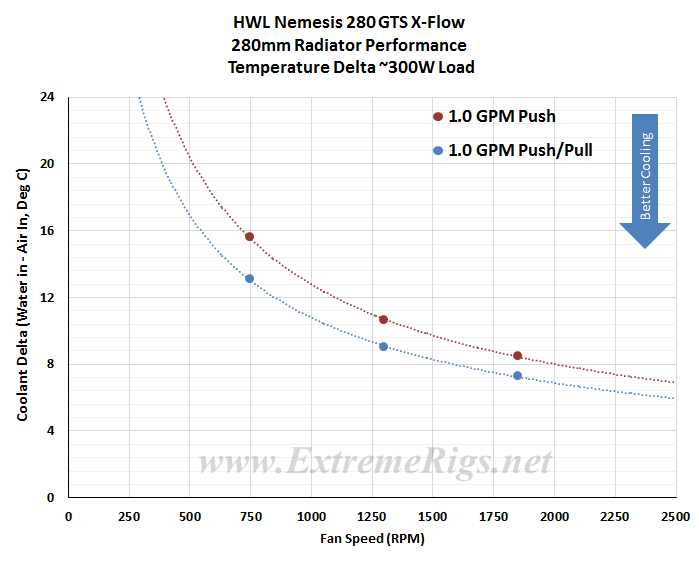 I was not too concerned about the actual delta numbers but instead the trend pattern. As we should expect, the deltas come down as the fan speed is increased. The less significant temperature drop from 1300 to 1850 rpm indicates the bulk of the radiators performance potential can be achieved with low and medium fan speeds.
I was not too concerned about the actual delta numbers but instead the trend pattern. As we should expect, the deltas come down as the fan speed is increased. The less significant temperature drop from 1300 to 1850 rpm indicates the bulk of the radiators performance potential can be achieved with low and medium fan speeds.
Delta T results (as above) are not always helpful when thinking about how many radiators you would need to cool your system. Instead it’s more useful to know the metric of W/Delta C. This metric is plotted below. It tells us how many Watts are dissipated by the radiator when the coolant rises 10C above ambient temperatures. (W/10 Delta T):
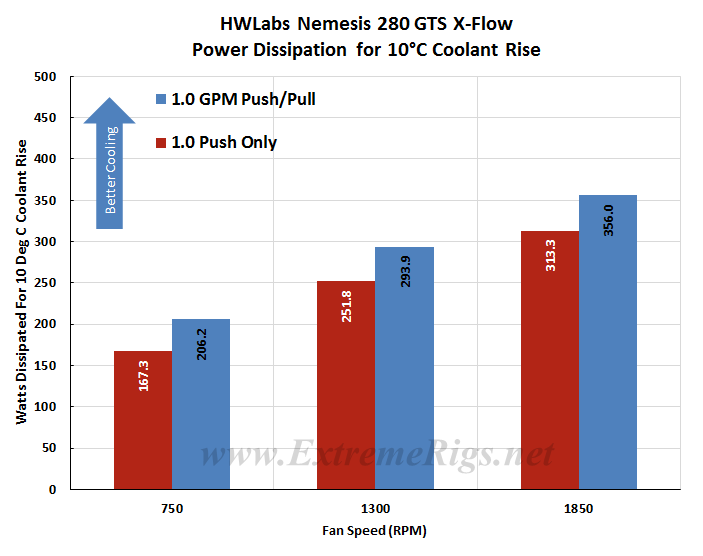 The average difference between Push Only and Push/Pull results at the same fan speed was ~15%, and ranged from ~19% at 750 rpm to 12% at 1850 rpm. A 15% average variance is very consistent with most radiators in the test group. However, while not seeming much, the 7% spread was one of the largest of the test groups and indicates that we may see some bias towards better performance with either a Push Only or Push/Pull fan assembly.
The average difference between Push Only and Push/Pull results at the same fan speed was ~15%, and ranged from ~19% at 750 rpm to 12% at 1850 rpm. A 15% average variance is very consistent with most radiators in the test group. However, while not seeming much, the 7% spread was one of the largest of the test groups and indicates that we may see some bias towards better performance with either a Push Only or Push/Pull fan assembly.
This same data can now be plotted on a chart so that an end user can interpolate their own fan speed. Note again that the extrapolation of the curve is much more sensitive to error than in between the tested range.
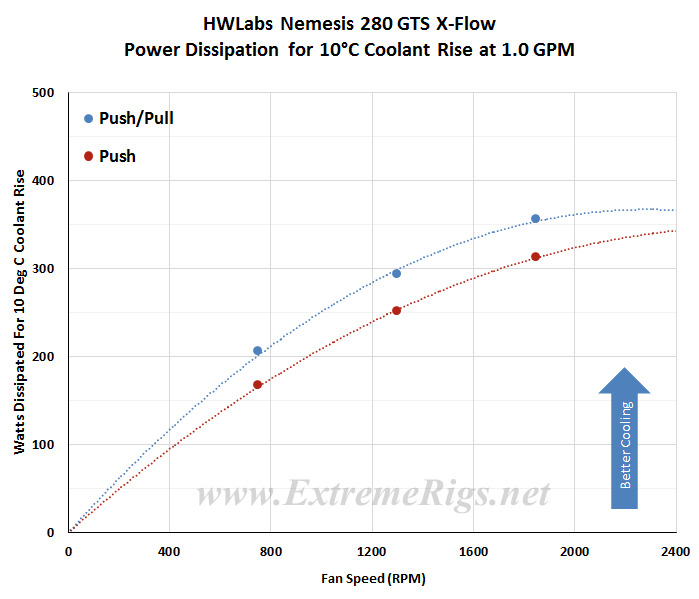 Interesting! The Push/Pull fan assembly seems to run out of puff (if the extrapolation is even roughly accurate) with very high fans speeds, while Push Only still has a little performance left to offer.
Interesting! The Push/Pull fan assembly seems to run out of puff (if the extrapolation is even roughly accurate) with very high fans speeds, while Push Only still has a little performance left to offer.
Now let’s analyze that data some more…
![]()








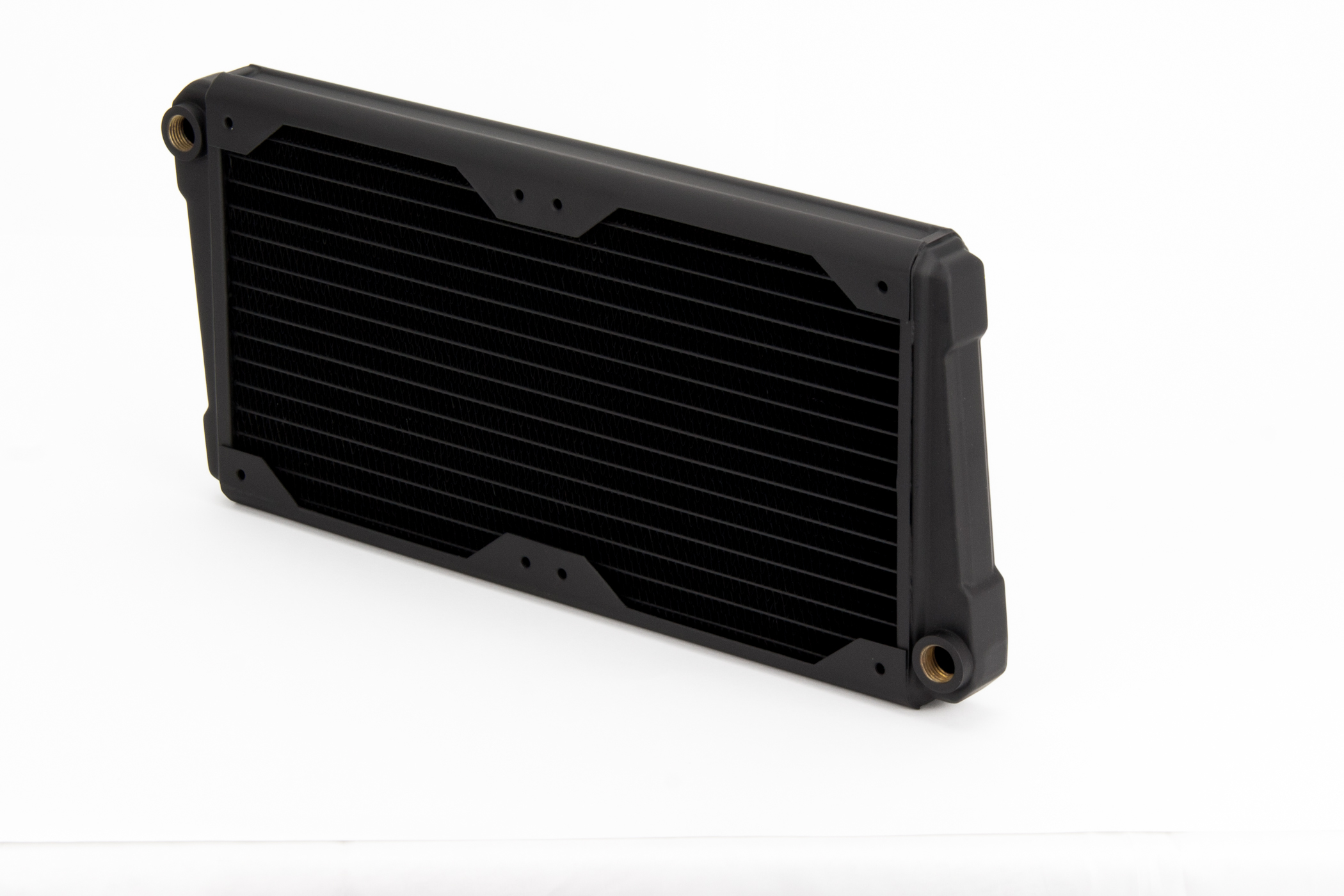



Its amazing how well this rad preforms considering how thin it is. I am very curious to see how it would stack up against a 280 30mm thick version of the Alphacool xflow (suppose to release around the June-August time-frame from what I was told by them)
I have a caselabs mercury s5 so i dont think the length would be a problem, my question is should i go with 2 of these or 2 45mm ek 280’s? cooling a cpu 5820k and a 1070 ftw.
HWLabs rads are sometimes a little wider than most and sometimes don’t fit in CaseLabs cases when you need to mount two next to them for example in the roof of a Mercury case. Measure up first and if in doubt maybe go with the EK ones
Comments are closed.